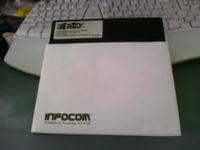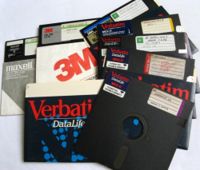Floppy disk
Diskettes, or floppy disks, were a popular medium of storing information in the 1970s up until the 1990s. They, and their drives were cheap to manufacture; unlike tapes, they are random access. The media isn't rigid, unlike the platters in hard disks, giving them the common name of 'floppies'.
As time went on the form factor of diskettes continued to shrink from 8" to 5 1/4", to 3 1/2". There were also some rare 3" diskettes that failed to gain a wide audience.
Contents
8" diskettes
8" floppy disks were popular in the 1970s until the early 1980s and could be found in consoles on mini computers (DEC, Norsk Data etc), mainframe controllers, and even down to CP/M computers. Capacities go from 79KB up to a 1.2MB capacity.
Acronyms for some common 8" diskette types are:
- SSSD => Single-Sided Single-Density, 237 KB
- SSDD => Single-Sided Double-Density, 499-614 KB (depending on sector size)
- DSSD => Double-Sided Single-Density, 500 KB
- DSDD => Double-Sided Double-Density, 1200 KB
('SSSD' is sometimes given as 'SS SD', 'SS/SD', etc; so too for all the others.)
Twiggies
This short lived format was only for the Apple Lisa computer. I recall hearing they were very temperamental, the drives would go out of alignment often, destroying data..
5 1/4" diskettes
These floppy disks were immensely popular back in the day with the low density variation being used in Apple, Atari, Commodore, and IBM compatible computers. Capacities ranged from 160KB up to 1.2MB for the high density disks.
Acronyms for some common 5 1/4" diskette types:
- SSDD => Single-Sided Double-Density, 164-184 KB
- DSDD => Double-Sided Double-Density, 360 KB
- DSQD => Double-Sided Quad-Density, 720K
- DSHD => Double-Sided High-Density, 1.2M
('SSDD' is sometimes given as 'SS DD', 'SS/DD', etc; so too for all the others.)
For a time after the 5 1/4" diskettes arrived they were called "minidiskettes". This term gradually faded from use when the earlier "standard size" 8" diskettes became less and less common.
3 1/2" diskettes
The original Mac was the first mainstream machine to ship with the 3 1/2" floppy disk, with a formatted capacity of 400KB as it was single sided. Capacities went up to 2.88MB. While encased in a hard shell, they still had the same flexible media type of prior diskettes. This did lead to some confusion with people referring to these as hard disks...
3" diskettes
A few vendors tried out a 3" floppy disk format. Among those were Amstrad, in the early Amstrad PCW models before 1991 (when they switched to the by then industry standard 3 1/2" format).
2" diskettes
These floppies had a rigid case like 3 1/2" floppies, only smaller. They were mostly used in Japanese digital video cameras and some word processors. Various incompatible formats existed. One model was a Canon 'Video Floppy Disk' called VF-50.
At least two (also incompatible) variants were developed for PC usage, according to InfoWorld Magazine, July 31, 1989 (and they got that info from Dave Sewall, business manager for diskettes at 3M Corp at the time). One by Sony, the other by Matsushita, who owns Panasonic. This latter type was used by the Zenith Minisport laptop, 1989.
From a picture at www.oldcomputers.net it looks like Fuji was one second-source for the Matsushita/Panasonic floppies (Fuji Film LT-1 floppies), unless the Infoworld article is inaccurate about the origin of the Zenith floppy. The Zenith drive used the same disk controller interface as for a 3 1/2" floppy drive, and the capacity was the same: 1MB unformatted (720KB formatted, presumably, although the Infoworld article says '760 megabytes'!).
The Sony variant of the 2" floppy, never actually used in PCs as far as we know, could store 812KB and transfer data at 14.3 Mbs, which was vastly faster than standard floppies which are in the sub-Mbs range (250kbs and up).




